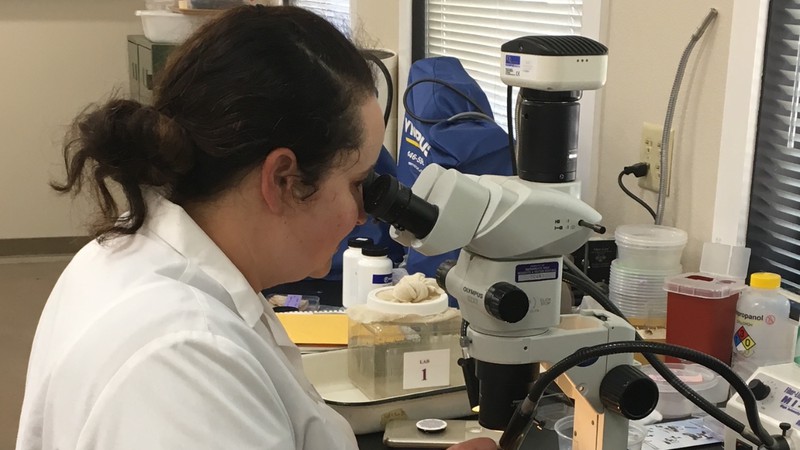
Dr. Sarah Wheeler, lab director of the Yolo-Sacramento Mosquito and Vector Control District. Courtesy YSMVCD
A rainy Labor Day weekend followed by a week of temperatures in the 80s and 90s created perfect breeding conditions for mosquitoes in a season when their population was already exploding.
Meanwhile, the record number of insects and birds testing positive for the West Nile Virus continues to spike.
As a result, the Sacramento-Yolo Mosquito & Vector Control District is maintaining a vigilant campaign to limit the number of mosquitoes and quash the spread of the sometimes deadly disease. As of this writing, there are 10 cases of West Nile virus in Sacramento County and eight in Yolo County, and one confirmed death in each.
The SYMVCD strategy is built on an ambitious and technologically sophisticated surveillance program carried out by a team of scientists working in an Elk Grove laboratory and an army of field technicians. The district has traps set out throughout the two counties, where it collects mosquitoes that are then tested for the presence of West Nile and other viruses. (Last month, the district collected a mosquito sample north of Woodland that tested positive for the rare St. Louis encephalitis virus)
Because the increasingly prevalent West Nile is a bird virus that causes some birds to get sick and die, the district also collects and tests dead birds to determine where the virus is active. As of this writing, the district has identified hundreds of infected mosquitoes and birds. It posts the locations of positive test-results on a map, which this summer is swarmed with location pins.
As soon as the results confirm a positive test for West Nile virus in a mosquito trap or bird, the district immediately dispatches a mosquito control team to the area.
Mission: Control
Dr. Sarah Wheeler, SYMVCD’s laboratory director, says her team approaches its job with increased urgency this season. “Everything happens really fast on results day,”
Every Monday and Wednesday, results begin arriving at the lab early in the morning and come in every three hours through the day. On the other side of the lab wall is a dashboard where the control team is waiting for those results.
“And let me tell you, they are ready for those results,” Wheeler says, “because as soon as the positives start rolling in, they start making a plan for what the appropriate control will be. “
As soon as the control team determines what the day’s mission will be, the first thing that happens is that email notifications are sent out to people who have signed up on the SYMVCD website to receive them.
“We always want the public to know exactly where we’re planning to go and what we’re planning to do,” Wheeler says.
Control crews are dispatched with “foggers” that deploy ultra-low volume (ULV) pesticides designed to target the two mosquito species that are causing trouble in the area. The four control teams—in north and south Yolo county and north and south Sacramento county—have been extremely busy this summer, thanks to the wet winter and spring that preceded it.
Fighting the Bite
The district has an arsenal of weapons at its disposal, including integrated pest management, ecological management—which now involves the use of drones—as well as biological and chemical controls. The tactic that gets the most public attention is the one that is used most rarely: aerial spraying in urban areas. So far this year, that has happened on only one occasion, on one night when a plane was deployed in Davis and in Woodland.
Wheeler reports that ordinarily results from Davis and Woodland come back on separate days, but in this case, the district decided it was imperative to get results from both cities as soon as possible. Surveillance and testing had shown disturbingly high numbers in two test metrics: abundance, which simply measures the number of mosquitoes present, and the infection rate, which is the number of mosquitoes per 10,000 determined to be carrying the virus.
The team decided to get a jump on the day and began work at 5am. They had already escalated their ground control efforts, Wheeler recalls, deploying the fogger trucks and hand-spraying perimeters. The airplane dusters had been spraying wetlands and rice fields where mosquitoes have been breeding in vast numbers.
The lab team performed what are known as “vector index calculations” to find out if their efforts were having an effect—bringing numbers down. That was not the case.
“The only thing we could do at that point to protect people from West Nile virus infection was put the plane up,“ Wheeler says.
Winning the War?
Wheeler says it’s impossible to know what might have occurred if the district had not made the decision to act quickly and aggressively attack the areas found to be infested with infected insects. Or to know how many people in the capital region or the Delta would have gotten sick or died if SYMVCD were not on the job.
The mosquito is by far the deadliest animal to humans on the planet. West Nile virus is the most serious vector-borne disease in California, and has resulted in more than 300 deaths since 2003. The first recorded mosquito control efforts in the state took place in 1904 and 1905. There has never been a study to find out what it would be like if there were no effort made to control mosquitoes.
“Honestly,“ Wheeler says, “we don’t have the data on that. That’s something we would like to know because then we could know how effective our control measures are. We can see infection rates and abundance levels change in response to our actions. But we can’t know what it would be like without vector control.
“I think if we did nothing, a lot more people would get sick. But we can’t know for sure.”
Long form articles which explain how something works, or provide context or background information about a current issue or topic.